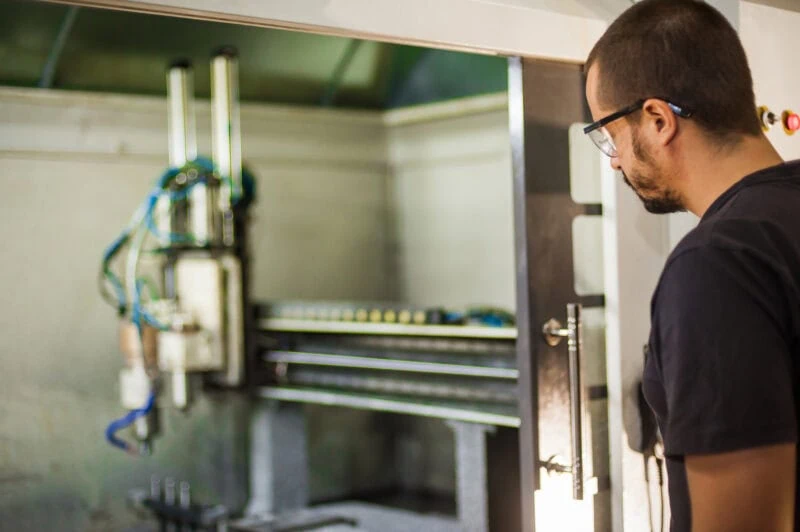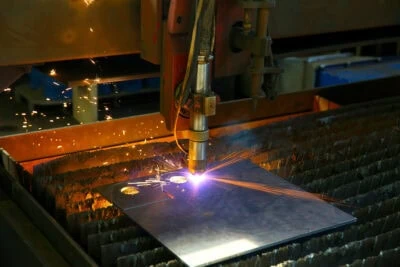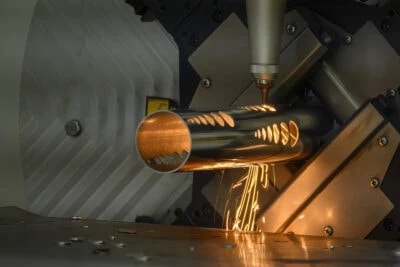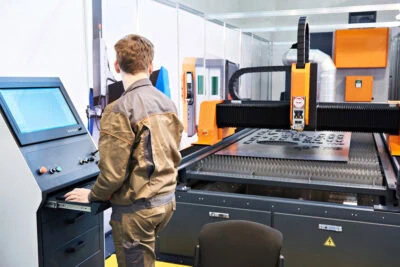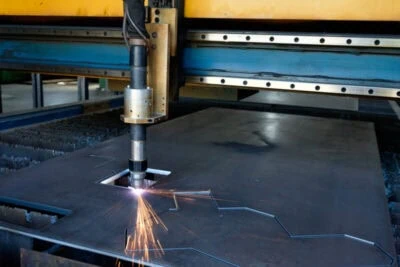Cutting technology has grown by leaps and bounds over the decades, and manufacturers across all industries will find many options to cut materials of all varieties.
From reflective materials like aluminum to thick metals like certain types of stainless steel, the best cutting process for your distinctive industrial needs depends on what you want to achieve in terms of operating cost, edge quality, and overall precision.
When it comes to modern cutting processes, there are two options that manufacturers tend to lean towards: laser cutting machines and plasma cutting machines.
Laser cutting and plasma cutting have several obvious similarities. For example, they both use intense heat to cut metal, cut wood, and cut materials of all kinds.
However, there are some key differences between laser cutting and plasma cutting. So, before deciding on the best cutting process for your operations, it’s essential to understand the fundamentals of laser cutting and plasma cutting to determine which of these versatile tools suits your company’s needs.
Table of Contents
How Does a Laser Cutter Work
Three Main Types of Laser Cutting Machines
How Does a Plasma Cutter Work
The Most Common Plasma Cutter Gas Types
The Main Differences Between Plasma Cutting and Laser Cutting
Laser Cutting vs. Plasma Cutting – Which is Better?
The Basics of Laser Cutting and Plasma
Laser and plasma cutting machines are versatile tools that function well with computer numeric control (CNC) manufacturing cutting processes. Both laser cutters and plasma cutters use inherent thermal processes to cut metals and other materials and are both found in manufacturing operations across all sectors.
How Does a Laser Cutter Work
Laser machines work by directing the energy of a laser beam onto a workpiece of metal or other material. The focused beam then uses this intense heat to melt the material, resulting in precise cuts.
Depending on the exact cutting process (as determined by the type of laser cutting machine), the laser may heat and melt the material using an assistive gas stream that concurrently blows the melted material away from the workpiece. Furthermore, the laser cutting machine may directly use the laser beam to change the metal or other material from solid form into gas – a process known as sublimation.
Three Main Types of Laser Cutting Machines – CO2 Laser Cutters, Crystal Laser Cutters, and Fiber Laser Cutters
CO2 Laser Cutters
CO2 laser cutters cut metal and other materials by utilizing electrically stimulated CO2. These laser cutting machines have been around for decades. They are some of the most popular in manufacturing because they can cut a variety of materials – including thick materials and thin materials – and they generally have a lower cost for companies that conduct laser cutting in house.
Crystal Laser Cutters
Crystal laser cutters, or Neodymium laser cutters, produce laser beams through Nd: YVO (neodymium-doped yttrium ortho-vanadate) and Nd: YAG (neodymium-doped yttrium aluminum garnet). These laser cutters can be cost prohibitive but work well with all sorts of metals like stainless steel, mild steel, and thick metal varieties.
Fiber Laser Cutters
Fiber lasers work in a similar way to CO2 laser cutters, but the light in fiber lasers is directed through a fiber optic cable to the cutting head before it is aligned to the workpiece that is being cut. A fiber laser can be more powerful than a CO2 laser cutter, which is why fiber laser cutting is on the rise in manufacturing industries. A fiber laser has a fast cutting speed and can produce precise cuts in all sorts of metals and thicker materials like stainless steel, mild steel, copper, and brass.
How Does a Plasma Cutter Work
Plasma cutting works by forcing a hot and electrically charged compressed gas through a small nozzle, which hits the metal or workpiece at a high rate of velocity and pressure, eroding and melting the cutting path along the way.
The combination of compressed gas, high speed, and pressure, along with an external electric charge, is what forms plasma. Then, it is loosely defined as an electrically conductive ionized gas that can reach temperatures as high as 20,000 °C.
In simplest terms, hot plasma is generated through the process of sending an electric arc through a gas, and the exact efficiency and success of the process depends on the type of gas (or, more commonly, gases) used in the plasma cutting process.
The most common plasma cutter gases include air, hydrogen, oxygen, nitrogen, and argon, and in addition to material thickness, the chemical characteristics, and the specifications (like cut or hole quality), will determine the plasma gas selection process.
The Most Common Plasma Cutter Gas Types
Compressed Air
Compressed air is the most common gas used in plasma cutting as it is versatile and inexpensive. Therefore, compressed air works best for lower current cutting on metals like mild steel, stainless steel, and aluminum.
Oxygen
Oxygen is commonly used for mild steel because it produces clean cuts and faster cutting speeds. In addition, oxygen works effectively in combination with other secondary gases, making oxygen cutting popular in multiple plasma cutting processes.
Nitrogen
Nitrogen is a gas utilized for higher current systems and is good for cutting thicker metals and materials. It is commonly used as a shield gas with argon hydrogen or as a secondary gas alongside compressed air or oxygen.
Argon
Argon is a rare gas that is more expensive but is unreactive with the cut metals. Using argon can help improve the stability of the plasma arc and prevent atmospheric contamination. However, argon is a gas that cannot operate alone, and it needs to be paired with a secondary gas.
Hydrogen
Hydrogen is an excellent thermal conductor and has inherent properties to quickly cool molten metal. As a result, hydrogen is commonly used for cutting aluminum and stainless steel, but it must be combined with other gases to produce a hot plasma flame.
Regardless of the gas used in the plasma cutting process, steel, stainless steel, aluminum, brass, and copper are among the most common metals cut with a plasma torch.
Only conductive metals can be used with a plasma torch because the workpiece is the final piece in the electrical arc used to cut metal.
Plasma cutting machines are used in various industries but are most commonly found in auto repair and restoration, fabrication ships, and industrial construction.
The Main Differences Between Plasma Cutting and Laser Cutting
There are a few critical differences between plasma cutting and laser cutting, which are as follows.
- Plasma cutters use a mixture of gases with an electrical arc, as opposed to laser cutters, which rely on a focused beam of light to conduct the cutting process.
- Laser cutters offer better precision than plasma cutters, as well as other types of cutting processes, like flame cutting or water jet cutting.
- Certain laser cutters, like fiber lasers, are best for cutting a thin metal sheet and can cut all metal types. Other types of laser cutters, like inexpensive CO2 laser cutters, do not work well with reflective surfaces, so they cannot cut as well through reflective metals like copper, brass, and aluminum.
- Plasma cutters are limited to just cutting metals and other materials. Laser cutters can cut metals, but they also have the ability to perform other fabrication processes, like engraving and welding.
- Laser cutters can generally cut metal faster than plasma machines and use less energy in the process.
- Plasma cutters can handle thicker materials than some types of laser cutting machines. Laser cutters can usually cut materials up to 25 mm thick , while plasma cutters can generally cut through any type of metal up to 80 mm thick . (Note: These specifications are generalizations, and the type of plasma or laser cutter used will determine what materials can be cut.)
Laser Cutting vs. Plasma Cutting – The Advantages of Laser Cutting
Laser cutters have some key advantages over plasma cutters, and these inherent benefits include the following
- Versatility – Laser cutters can cut a wide variety of thicker and thinner materials and are used to cut wood, metal, plastic, and ceramics. Plasma machines, however, can only cut conductive materials, primarily conductive metals.
- Speed – Laser cutters are more energy efficient, much faster, and better suited for conducting large production runs at a time. Because of this reduction in energy use, laser cutters are also more environmentally friendly than plasma machines and tend to have lower operating costs.
- Accuracy – A laser beam is concentrated on a tiny and specified area of the workpiece, producing a thin cutting seam (kerf) instead of the wider cuts produced by plasma machines. This makes laser cutting ideal for manufacturers requiring precise cuts, like medical devices or electronics companies.
The Disadvantages of Laser Cutting – Laser Cutting vs. Plasma Cutting
There are some potential drawbacks to laser cutting as well, which manufacturers should consider.
- Potential challenges with reflective materials – Unlike plasma cutters, some laser cutters do not perform as well on highly reflective surfaces. However, some of the best laser cutting machines (like fiber lasers) can overcome these challenges.
- Possible challenges with thick materials – Plasma machines can generally cut materials thicker than laser cutters can. However, this depends on the quality and type of laser cutting machine used in the cutting process.
- Potential challenges with cost – When it comes to purchasing and operating a cutting machine in-house, plasma machines win the cost comparison. Laser cutters are significantly more expensive to buy and operate than plasma cutters, but this cost can be mitigated by outsourcing your laser cutting needs.
Plasma Cutting vs Laser Cutting – The Advantages of Plasma Cutting
A plasma cutting machine has some potential benefits over a laser cutting machine including the following.
- Lower cost to purchase – A plasma cutter is inherently less expensive than a laser cutter, which is a primary consideration for companies that want to purchase and operate a cutting machine in house.
- Ability to cut thicker materials – A plasma machine can generally handle thicker materials better than a laser cutting machine, as well as other types of cutting machines or cutting processes, like flame cutting.
- Lower in-house maintenance – While laser cutting machines require special facilities, trained operators, and other costly investments, plasma cutting machines require less maintenance and less expertise.
Plasma Cutting vs Laser Cutting – The Disadvantages of Plasma Cutting
As stated, a plasma cutter does not have all the functionality a laser cutter can offer. As such, there are some notable disadvantages to opting for a plasma cutter over a laser cutter for manufacturing processes.
- Plasma cutting machines can only handle conductive materials – One of the most noticeable disadvantages of plasma cutting machines is that they cannot work with nonconductive materials, so they can only be used on conductive metal (or other conductive materials.)
- Limited functionality – In addition to only handling conductive materials, plasma cutting machines cannot perform all the functions of a laser cutting machine, like engraving.
- Not suited for precise cuts – The larger kerf of a plasma cutter means that it is not as accurate as a laser cutter, which makes it unsuitable for cutting processes that require highly detailed cuts and marks. In addition, plasma cutting machines can be subject to other errors, like heat distortion.
- Radiation – Plasma cutters, unlike laser cutting machines, create radiation, so protective equipment must be used when operating a plasma cutting machine.
- Slower cutting speed – While plasma cutting machines are suitable for cutting thicker materials, they do not have the high cutting speed of laser cutters. As such, a laser cutting machine is a better choice for manufacturers who must conduct operations at a high speed.
Laser Cutting vs. Plasma Cutting – Which is Better?
When it comes to laser cutting vs. plasma cutting, the answer to which is better depends on a company’s needs.
Manufacturers with simpler jobs and less detailed cuts required (and those who want to operate their cutting machine in house) will likely opt for plasma cutting. Laser cutters, while more expensive, can handle more intricate jobs with better accuracy and at a high rate of speed.
Simply put, the debate of laser cutting vs. plasma doesn’t have a clear and obvious winner. However, there are ways that manufacturers can enjoy the benefits of laser cutting without incurring the high cost involved.
Your Best Resource for Laser Cutting Services is Steelway Laser Cutting
Even if your business has routinely relied on plasma cutting in the past, laser cutters can revolutionize your operations and allow you to create parts and products that are more precise and have a faster turnaround time.
The key to enjoying the full benefits of laser cutting is to work with an expert partner that offers time-tested, reliable, and exceptional laser cutting services so that you can enjoy the best technology without the cost.
Reach out to Steelway Laser Cutting today to learn more. With Steelway, you’ll have a better way to manufacture your parts and products and will be able to end the debate of laser cutting vs. plasma cutting once and for all.
